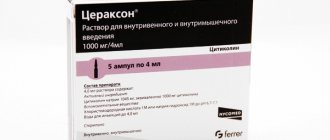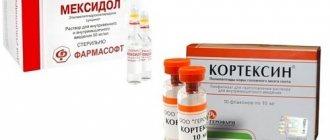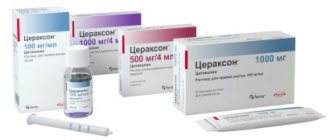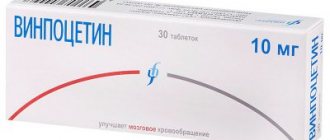Pharmacological properties of the drug Ceraxon
Citicoline stimulates the biosynthesis of structural phospholipids in neuronal membranes, which improves membrane function, including the functioning of ion exchange pumps and neuroreceptors. Due to its stabilizing effect on the membrane, citicoline has anti-edematous properties and reduces cerebral edema. Citicoline reduces the severity of symptoms of cerebral dysfunction after pathological processes such as traumatic brain injury or acute cerebrovascular accidents. Citicoline reduces the level of amnesia, improves the condition of cognitive, sensory and motor disorders, and also weakens the severity of symptoms that are observed with hypoxia and cerebral ischemia, including memory impairment, emotional lability, and impaired ability to perform normal self-care activities. Citicoline is a natural compound found in the human body, so classical pharmacokinetic studies cannot be performed due to the difficulty of quantifying exogenous and endogenous citicoline. During a pharmacokinetic study, its almost complete absorption in the gastrointestinal tract was determined - less than 1% of the dose taken was detected in the feces within 5 days after taking the drug. Two peaks of radioactivity were also noted in the blood plasma, due to metabolism in the liver and intestines: the first - after 1 hour, the second - after 24 hours. Bioavailability by oral and parenteral routes of administration is almost the same. Excretion is very slow, mainly through the respiratory system and urine. After 5 days of administration, about 16% of the drug dose was detected, which indicates the inclusion of the rest of the dose in metabolic processes.
V.V. Afanasiev Department of Emergency Medicine St. Petersburg MAPO
Introduction Ceraxon (INN – citicoline) is a lipidergic drug whose action is associated with the membrane biochemical Kennedy cycle (Fig. 1). This cycle ensures choline homeostasis in the human body, and its metabolic pathways create conditions for the formation of phosphotidylcholine, the main lipid component of the biological membranes of cells in most organs and systems. Thanks to the constant replenishment of the concentration of phosphotidylcholine, the composition of biological membranes and their basic properties (fluidity, integrity, matrix and frame functions, etc.) are preserved. This ensures the operation of various receptor and transport mechanisms localized in the membranes of many cells. The complex biochemical interactions that occur in lipidergic membrane systems are not fully understood. Many reactions simultaneously occur in opposite directions upon initial stimulation with one substrate, while the substrates themselves are capable of changing the rate of reactions in different directions. Some partial reactions are easily reversible, others occur only in one direction. The intensity of phosphatidylcholine formation is also regulated by the environmental conditions in which the biotransformation of glycerolipids occurs (pH, osmolarity, presence of coenzymes, etc.); finally, the Kennedy cycle is closely related to other biochemical cycles that supply substrates to its “cauldron”. It is possible that this is why the administration of known phospholipid complexes, such as lipostabil, essentiale, etc., has a certain membrane-protective effect, but their administration for various diseases does not at all mean stimulation of the biochemical component needed in a given clinical situation, i.e. these drugs are not specifically targeted . Citicoline is a native substance of targeted action, which can be compared with selectively acting synaptotropic agents, when the drug interacts with the receptor according to the target principle. In this case, the target is the conversion reaction of cytidine-5-choline phosphate to phosphotidylcholine, since cytidine-5-choline phosphate is the biochemical name for citicoline. Thus, Ceraxon is a high-tech liquid dosage form of cytidine-5-choline phosphate that prosthetizes the main partial reaction of the Kennedy cycle. In our country, Cerakson appeared recently; in Western European countries, the history of its use goes back more than 30 years, during which considerable experience in its clinical use has been accumulated. The appearance of Ceraxon is not accidental. It is well known that the path of any drug from the laboratory to use in practice takes at least 15 years and the material costs of identifying specific activity, chronic toxicity and, finally, clinical trials are preceded by a strict pharmacological analysis between “structure and action”. Cerakson appeared at a time when scientific progress in the field of understanding “neurotransmitter” and “lipidergic” diseases had stepped forward. In the pathogenesis of many diseases of the nervous system, in particular, key disturbances have been identified that occur in the autocoid homeostasis of synaptic systems and biological membranes. Some of them, occurring in the lipidergic systems of the membranes of cell clusters of the central nervous system, are presented in table 1. The structural formula of Ceraxon includes phosphorylated cytidine (which is a pyrimidine nucleotide) and choline, which also plays an important regulatory role in the body. Cytidine, together with other nucleotides, forms a system of purine and pyrimidine ribonucleotides (ATP, GTP, CTP, UTP, TTP), which, in addition to their main role, serve as secondary messengers in the post-receptor interaction between membrane receptors and cell plasmon. Choline serves as a structure-forming component of the Kennedy cycle. On the one hand, it is a precursor for the formation of phosphatidylcholine, and on the other hand, under certain circumstances, for example during depletion, it can serve as a source of replenishment of the mediator acetylcholine*. Let us emphasize once again that both components of the citicoline molecule are native compounds that are present in the human body. This does not mean at all that, being developed in the form of a liquid dosage form intended for intravenous administration, the components of Ceraxon are dietary supplements that can be used or not used with the same benefit for the patient (a product such as glucose is also a native substance, but it is well known that in clinical practice its solutions are used differentiatedly and strictly according to indications). Thus, citicoline is a high-tech product consisting of important regulatory metabolites of the human body that are part of the membranes of cell clusters of almost all types (Fig. 2).
Partial reactions of the Kennedy cycle and features of the clinical use of citicoline The vector of the main action of citicoline is aimed at the synthesis of phosphatidylcholine (Fig. 3). The latter is a glycerophospholipid, from which important cell components such as surfactant, myelin, other glycerophospholipids and sphingophospholipids are subsequently formed. The Kennedy cycle is linked to glycolysis and the Linnen cycle via Acetyl-CoA (see Fig. 1), and the direction of its reactions also depends on the voltage of glycolytic reactions, glucose levels, Acetyl-CoA concentration and the rate of acetylcholine formation. Citicoline is separated from the formation of phosphatidylcholine by one reaction catalyzed by the enzyme choline phosphotransferase, during which phosphatidylcholine and cCMP are formed (Fig. 3). It is very important to draw the reader’s attention to the fact that partial reactions of the Kennedy cycle occur under a number of conditions, when the clinical situation for the treatment of a seriously ill patient may “come into conflict” with the conditions necessary for the action of the drug. Such conditions include ventilation mode (hypocapnia, hypercapnia, pO2art level, glycemic level, administration of coenzymes, dehydrogenases, etc., see Fig. 3). Maintaining optimal ratios can increase the potency of Ceraxon. This circumstance is very important and requires clinical consideration when prescribing citicoline to patients not only in the ICU, but also in everyday practice. In clinical settings, decreases in pO2art and blood glucose levels are one of the most common changes in the homeostasis of patients. Thus, acidosis will be accompanied by an increase in the level of choline and cytidine-5-choline phosphate (citicoline), while alkalosis, on the contrary, will be accompanied by a decrease in the amount of these substrates. Low pO2 values and hypoglycemia will cause a decrease in the formation of cytidine-5-choline phosphate, which will require additional administration of citicoline, oxygen therapy and, possibly, isotonic hemodilution with glucose solutions. Considering the wide breadth of therapeutic action of Cerakson, at first glance, when the specifics of the clinical action of the drug in various diseases have yet to be clarified, we believe that the ED50 of citicoline for ischemic stroke, cerebral edema, head injury should be at least 2 g per administration in the “average” -standard situation." Moreover, oxygen therapy and administration in saturating and maintenance doses will help increase the potency of the drug. According to our calculations, the optimal regimen for administering Cerakson is to prescribe it in saturating (Sn) and maintenance (Sp) doses. This tactic makes it possible to maintain a stable effective concentration of the drug (Css) in the blood plasma of an “average-standard” patient with a body weight of 80 kg. Dnciticoline = 1-2 g (2 g is optimal), Dpciticoline = 0.008 g/min. Of course, such an appointment can only be carried out using a syringe infusion pump. For routine practice, it can be recommended to administer DP as slowly as possible (the so-called “therapeutic” administration of no more than 30 drops/min). This method of prescribing citicoline allows for timely correction of the conditions that ensure the main effect of the drug (see Fig. 3). The transformation of citicoline into surfactant and into myelin is a complex enzymatic process controlled by phospholipases and other enzymes. To enhance the biotransformation vector of Ceraxon when combined with drugs of other pharmacological groups in the treatment of COPD, demyelinating diseases of the central nervous system and other pathological conditions, it is also necessary to take into account the conditions that affect the rate of partial reactions in the metabolic pathways of surfactant and myelin formation. This is a task for the future. The transition of phosphotidylcholine to endogenous choline is carried out under the influence of phospholipase (PL) enzymes, and this reaction is very important in ensuring choline homeostasis [23]. On the one hand, it “balances” the concentrations of substrates of the Kennedy cycle, and on the other, it becomes a source of “absorption” of phosphotidylcholine during hypoxia, inflammation and other basic pathological conditions. Lysis of phosphotidylcholine leads to a disruption of the conformational properties of membranes, as a result of which the position of the receptor proteins located in their composition changes. The more severe the hypoxia, the greater the consumption of phosphotidylcholine. Depletion of its pool exceeding 20% is accompanied by membrane death [8]. Donating a source of phosphotidylcholine can replenish its reserves, but does not eliminate the cause of the disease, therefore, citicoline, first of all, should be considered as a universal membrane protector capable of preserving the framework and matrix properties of biological membranes, as evidenced by some of the works that we will present below. Let us note once again that for their successful implementation, a number of conditions are necessary that should be observed in the clinic when prescribing Ceraxon, especially in an ICU, timely “supplying” coenzymes (ascorbic acid, thiamine, etc.), manipulating glucose solutions and blood gases ( see Fig. 3), in other words, very carefully monitoring the patient’s condition. This is the first condition arising from the analysis of the biochemical pharmacology of Cerakson, which is necessary for the successful operation of the drug.
The role of citicoline in ensuring the framework and matrix properties of biological cell membranes Membranes of all types (cellular, cytosolic, nuclear) contain receptors. Plasma membranes contain, among others, receptors for cholinergic systems. Disruption of the glycerophospholipid basis of membranes, which is made by phosphatidylcholine, changes the conformation of membranes, their polarization, which entails a violation of mass transfer controlled by receptors of cholinergic systems, making them insensitive (or excessively reactogenic) when prescribing synaptotropic drugs (in this work we will consider the effect of citicoline in relation to cholinergic regulation , without affecting other mediator systems.** Moreover, the activity of transport pumps of another organization changes (for example, ATPases, hexokinases, chlorine-carbonate symports, etc.), which entails a deficiency of substrates supplied to the cell and impaired evacuation from it metabolic products. In acute diseases, such as ischemic stroke, head injury, spinal shock, alcoholic pathology, the deficiency can be so pronounced that it becomes incompatible with life. Thus, in hemorrhagic stroke, membrane damage, manifested by the formation of hydroperoxides of their lipid components , are the most important link in the pathogenesis of this disease [6]. In chronic diseases (especially the nervous system and liver), it leads to a progressively increasing decrease in chemical synthesis (for example, in the formation of myelin, surfactant, glycogen, and other formations), including energy production. By prosthetizing the phosphotidylcholine part of the membranes, citicoline prevents the development of these disorders or mitigates their consequences. Proof of this fact is the research of F. Cohadon et al. [14], who showed restoration of ATPase activity and a decrease in the intensity of cerebral edema (Fig. 4).
Citicoline in choline homeostasis Disorders of carbohydrate metabolism are accompanied by a failure of cholinergic neurotransmission (their syntheses are “arranged on floors”). Long-term depolarization of presynaptic membranes of cholinergic neurons during excitotoxicity, for example against the background of energy deficiency (for example, in severe hemispheric ischemic stroke, when a patient, especially an elderly one, has not been fed for two days), is always accompanied by an increased need for choline and Acetyl-CoA, necessary to restore the pool of the neurotransmitter acetylcholine. However, this need cannot be realized, because under conditions of low membrane potential and energy deficiency, peptidergic transport pumps operate with low efficiency (O'Regan et al., 1980), and the acetylcholine mediator reuptake system, especially in the elderly age, emaciated (Francis, 1994). Cholinesterase “works”, but choline is not utilized by the presynaptic membrane. For some time, choline reserves for the synthesis of acetylcholine mediator can be maintained due to the hydrolysis of phosphatidylcholine by phospholipases (Ulus et al., 1989). However, a decrease in the concentration of Ptd-Chol is clearly accompanied by the death of the cholinergic cluster [30]. This biochemical constellation is called “autocannibalism” of phosphotidylcholine [8, 23], as a result of which both pairs of participants die (Fig. 5). Just as the protective reaction of centralization of blood circulation during traumatic shock becomes a factor of aggression, consumption of Ptd-Chol, aimed at protecting cholinergic transmission, becomes a source of death of the cell cluster. In other words, the more severe the hypoxia, the greater should be the dose of citicoline and the conditions that ensure its stable concentration in the brain tissue. This can be achieved by combining Ceraxon with other drugs. Analysis of the pharmacokinetics of Ceraxon allows us to conclude that the formation of acetylcholine in brain tissue, measured after administration of the drug, increases very slightly, while the level of choline reaches Cmax by the 20th minute after administration of Ceraxon (Coviella et al., 1987) . The studies of the above authors and the analysis of the pharmacodynamics of citicoline allow us to draw three important clinical conclusions:
• the formation of acetylcholine after the appointment of Ceraxon will increase if, before prescribing the drug to the patient, a certain “preparation” is performed, at least hemodilution is performed with a glucose solution, together with substances that disinhibit glycolysis “at the exit” (nicotinamide, riboxin, thiamine, etc. ); • if at the height of choline formation the patient is prescribed choline-containing drugs, the level of phosphatidylcholine will remain for other chemical syntheses; • combinations of Ceraxon with blockers of phospholipase activity are likely to preserve the pool of phosphotidylcholine in cells (at least (preliminary report by N.V. Petrova, 2009 requires study).
Mechanisms of action of citicoline
Main action A). Lipidergic action, which allows maintaining the compositional, framework and matrix properties of the membranes of cell clusters (neuronal, myocardial, hepatocyte). This is the main effect of Ceraxon, which forms the polyvalency of its action. Its essence lies in the formation of phosphotidylcholine (and other phospholipids [17, 20, 21], de la Morena, 1991), due to which the membranes continue to function under conditions of hypoxia and ischemia. If the frame is preserved, then its contents are retained in it, i.e. receptors, cholesterol, mediators of post-receptor signals, etc., ensuring mass transfer in them. This means maintaining glycolysis, at least partially, and reducing excitotoxicity, albeit indirectly (note that there are no direct antagonists of NMDA activity today). This is confirmed by the experimental studies of Tserakson, which established:
• preservation of the activity of membrane antiports when the drug is prescribed, in particular, the concentration of ATPases and other pumps, due to the work of which cerebral edema is resolved [14]; • reduction in the concentration of non-esterified fatty acids and arachidonic acid, which provide adhesive-inflammatory and platelet reactions [13, 27]; • reduction of infarct volume during ischemia [29].
It is this polyvalency of Cerakson’s action in clinical settings that allows:
• restore motor deficit; • restore walking; • improve psychometric test scores compared to placebo; • restore the ability of 51.6% of patients to self-care (while in the placebo group this ability was registered in 24.2% of patients) [22].
A correct understanding of the mechanism of action of Cerakson allows us to outline the prospects for its combinations with other agents (see below). B). Ceraxon is a donor of CTP, which is involved in the synthesis of pyrimidine nucleotides. IN). Ceraxon improves microcirculation due to its “vasoactive and antiplatelet” action ([13, 18, 20, 26, 28], de la Morena, 1991; Masso, 1991). Note that the antiplatelet effect is realized only from the phospholipids of the vascular membranes.
Other types of action A). Citicoline is a participant in chemical syntheses in the formation of choline and acetylcholine ([20], Arrigoni et al., 1987). B). Ceraxon stabilizes the concentration of the transmitter dopamine by increasing the activity of tyrosine hydroxylase. IN). In addition, Ceraxon can serve as a multi-system glutamate antagonist (especially in the presence of cholinergic drugs). G). Citicoline is a catecholamine liberalizer due to stimulation of H-CRS (this property is usually considered negative, but it may not be superfluous when providing inotropic support to seriously ill patients).
Side effects of citicoline All, without exception, authors who have used Ceraxon note its good tolerability, even when prescribing high doses of the drug, but side effects still occur:
• CVS: hypotension, bradycardia. Tachycardia was observed in 0.6% of patients who were prescribed the drug orally [19]. • Gastrointestinal tract: nausea, vomiting, gastralgia and diarrhea - occurs in patients receiving citicoline orally [18, 19], however, in a study of 2,800 patients, the incidence of these symptoms was 4% [19, 25]. • Neurological disorders: dizziness, a feeling of “being overwhelmed”, tremor – sometimes occurring phenomena when taking citicoline orally [18].
Doses and methods of administration of citicoline for various diseases The breadth of the therapeutic action of Ceraxon allows it to be prescribed in a wide range of doses. However, in our opinion (see above), the optimal dose of the drug for the treatment of ischemic disorders is a dose of 2 g/day per administration. However, below we present studies by some foreign authors who used the drug in other doses:
1) Multi-infarct dementia: 1000 mg/day, preferably in the morning [16]. 2) Parkinson's disease: 500-1000 mg/day (once or twice a day) in patients receiving levodopa [9, 24]. The course of treatment is from 10 to 30 days.
Intravenous administration: 1. Ischemic stroke: 2,000 mg/day ([15], Stroke 2002; 33: 2850-2857). For parenteral administration, the solvent can be 5% glucose solution or water for injection [28]. Overall, an analysis of 4 randomized, double-blind controlled trials conducted in 1,372 patients treated for moderate to severe IS (NIHSS ≥ 8, Rankin Scale ≤ 1) with a treatment duration of 3 months showed that the most the effective dose of the drug (among the three doses evaluated in the study: 500, 1,000, 2,000 mg/day, prescribed in the next 24 hours from the onset of the first symptoms of IS) is a dose of 2 g/day. With this prescription of Ceraxon, complete recovery was recorded in 27.9% of treated patients. According to the conclusion of the authors [15], the administration of Ceraxon at a dose of 2 g/day increases the likelihood of a favorable outcome by 33% in the overall group and by 38% in the group, therefore, when treating ischemic stroke, one should focus on this dose of the drug, as on ED50.
Oral administration:
1. Patients with multi-infarct dementia: 1,000 mg/day (time of administration not established [11]. 2. Patients with Parkinsonism: 400 mg three times a day in addition to levodopa therapy [18]. 3. Treatment of the consequences of ischemic stroke: 100 to 800 mg/day (U50 = 600 mg).Preferred dosing time has not been established [19].
The physiological role of citicoline and the presented mechanisms of its action determine the breadth of use of this drug in modern clinical practice (Fig. 6.) Today, the scope of use of Ceraxon in Russia is limited to the following indications:
1. Acute period of ischemic stroke; 2. Recovery period of ischemic and hemorrhagic stroke; 3. TBI (acute and recovery periods); 4. Cognitive impairment in vascular and degenerative diseases of the central nervous system; 5. Parkinsonism.
Conclusion The effect of Ceraxon on the stages of the ischemic cascade is a proven fact [7]. However, the experience of clinical use of Ceraxon does not yet allow us to summarize the results of our own studies. Today, we can conclude that Ceraxon has a wide range of therapeutic effects, its safety and its good tolerance by patients. This makes it possible to maneuver the doses of the drug and use it together with substances from other pharmacological groups. Using the methodology developed at the Department of Emergency Medicine (calculation of the vector of the main action of drug combinations), we will take the liberty of suggesting that combinations of Ceraxon with drugs of certain pharmacological groups can exhibit a coergic effect. Certain formulations are currently being studied at the Department of Emergency Medicine of St. Petersburg Medical Academy of Postgraduate Education and the Department of Neurology of the Russian State Medical University (Table 2). Thus, in terms of the mechanism of action, systemic effects, clinical application options and pharmacological “portrait” in general, Ceraxon is a promising drug, the therapeutic effect of which can be used not only in neurology, but also in other clinical disciplines.
Literature 1. Anichkov S.V. Selective action of mediators. M.: "Med", 1971; 312. 2. Bazarevich G.Ya., Bogdanovich G.S., Volkova N.A. Neurotransmitters in the regulation of external respiration. M.: "Med", 25-68. 3. Denisenko P.P. The role of cholinergic systems in regulatory processes. M.: "Med", 1980; 296. 4. Kolman Y., Rem K. Visual biochemistry. M.: "Mir", 2000; 469. 5. Nikonov V.V., Savitskaya I.B. New possibilities of combined neuroprotection for ischemic stroke // Neuroscience: theoretical and practical aspects. 2007; 3: 1-2: 85-88. 6. Rumyantseva S.A., Silina E.V., Afanasyev V.V. Neuropathology and psychiatry. 2009; 109:3:64-68. 7. Skvortsova V.I., Botsina A.V. Neuroprotective therapy in the acute period of cerebral stroke // Doctor. 2007; 12:25-28. 8. Adibhatla RM, Hatcher J. Role of lipids in brain injury and diseases // Future Lipidol. 2007; 2:4:403-422. Advenier C., Rigoli D., Antihistaminiques. Sem. Hop., v. 63, N 21, p. 1699-1710. 9. Agnoli A., Ruggieri S., Denaro A. et al. New strategies in the management of Parkinson's disease: a biological approach using a phospholipid precursor (CDP-choline). Neuropsychobiology. 1982; 8: 289-296. 10. Andersen M. et al. // Stroke 1999; 30: 1464-71. 11. Cacabelos R., Alvarez XA, Franco-Maside A. et al. Effect of CDP-choline on cognition and immune function in Alzheimer's disease and multi-infarct dementia // Ann NY Acad Sci. 1993; 695: 321-323. 12. Cancev M., Yilmaz M., Ilcol Y. Cardiovascular effects of CDP-Choline and its metabolites: involvement of peripheral autonomic nervous system // Eur J Pharmacol. 2007; 577: 1-3: 129-142. 13. Ceda et al. Alpha Glycerylphosphorylcholine administration increases the GH responses to GHRH of young and elderly subjects // Horm Metab Res. 1991; 24:3:119-21. 14. Cohadon F. et al. // Nourochirurgie. 1982; 28: 287-290. 15. Davalos A., Castillo J., Alvares-Sabin et al. // Stroke. 2002; 33:12:2850-2857. 16. di Perri R., Coppola G., Ambrosio LA et al. A multicentre trial to evaluate the efficacy and tolerability of a-glycerylphosphorylcholine versus cytosine diphosphocholine in patients with vascular dementia // J Int Med Res. 1991; 19: 330-341. 17. Dinsdale JRM, Griffiths GK, Castello J. et al. CDP-choline: repeated oral dose tolerance studies in adult healthy volunteers // Arzneimittelforschung. 1983; 33: 1061-1065. 18. Eberhardt R., Birbamer G., Gerstenbrand F. et al. Citicoline in the treatment of Parkinson's disease. Clin Ther. 1990; 12: 489-495. 19. Fernandez RL Efficacy and safety of oral CDP-choline // Arzneimittelforschung. 1983; 33: 1073-1080. 20. Garcia-Mas A., Rossinol A., Roca M. et al. Effects of citicholine in subcortical dementia associated with Parkinson's disease assessed by quantified electroencephalography // Clin Ther. 1992; 14: 718-729. 21. Gelenberg AJ, Dorer DJ, Wojcik JD et al. A crossover study of lecithin treatment of tardive dyskinesia // J Clin Psychiatry. 1990; 51: 149-153. 22. Goas JY et al. Symposium International: Souff rance Cerebrale et Precurseurs des Phospholipides (Jan 18 Paris), 1980. 23. Li Z., Agellon L., Vance D. Thematic review series; glycerolipids. Phosphatidylcholine and choline homeostasis // J Lipid Res. 2008; 49:6:1187-1194. 24. Marti JF, Urtasun M. Citicoline in the treatment of Parkinson's disease // Clin Ther. 1991; 13: 239-242. 25. Micromedex, Inc., Drugdex., 2009. 26. Spagnoli A. & Tognoni G. 'Cerebroactive' drugs: clinical pharmacology and therapeutic role in cerebrovascular disorders // Drugs. 1983; 26: 44-69. 27. Suno M. et al. // Yakuri to Chiryo. 1985; 13: 10: 165-170. 28. Tazaki Y., Sakai F., Otomo E. et al. Treatment of acute cerebral infarction with a choline precursor in a multicenter double-blind placebo-controlled study // Stroke, 1988; 19: 211-216. 29. Schabitz WR // J Neurol Sci, 1996; 138: 21-25. 30. Wurtman RJ Choline metabolism as a basis for the selective wulnerability of cholinergic neurons // Trends Neurosciences. 1992: 15: 117-122.
*It is generally accepted that recycling of acetylcholine (in particular, its reuptake by the presynaptic membrane) occurs with the participation of a special peptidergic system and is the main way to replenish the acetylcholine pool in cholinergic neurons. However, when the activity of the cholinergic response decreases, choline from the Kennedy cycle can replenish the acetylcholine deficiency. This is fraught with a significant adverse consequence - a decrease in the reserves of phosphotidylcholine in cell membranes, which is called “phosphotidylcholine autocannibalism” (Adibtatla, 2005). **This provision also applies to receptors of other mediator systems, for example adrenergic, dopamine, serotonergic, which is extremely important, for example, when providing inotropic support in seriously ill patients.
Use of the drug Ceraxon
The solution for oral use in adults is prescribed 200 mg (2 ml) orally 3 times a day. For children, the drug can be prescribed orally from the moment of birth - 100 mg (1 ml) 2-3 times a day. The duration of treatment depends on the severity of the brain damage. The minimum recommended period is 45 days. The dose of the drug and the duration of treatment can be changed by the doctor. The drug, pre-mixed with a small amount of water, is taken using a dosing syringe. It is necessary to rinse the dosing syringe with water after each use. IV or IM administration In acute and emergency conditions, the maximum therapeutic effect is achieved when the drug is administered in the first 24 hours. IV is administered slowly (injection duration - 5 minutes) or drip (infusion rate - 40-60 drops per minute) . Treatment begins with prescribing the drug for the first 2 weeks, 500–1000 mg (depending on the patient’s condition) 2 times a day intravenously. Then - 500–1000 mg 2 times a day IM. The maximum daily dose is 2000 mg. If necessary, treatment is continued with the drug in the form of an oral solution. The recommended duration of treatment, at which the maximum therapeutic effect is noted, is 12 weeks. It is recommended for children to prescribe Ceraxon in the form of a solution for oral use.
special instructions
Treatment with Cerakson is often prescribed to premature babies and newborns with brain tissue injuries received during childbirth. The treatment regimen is determined by the attending physician and depends on the Apgar assessment of the child’s condition. Storing the medicine in the refrigerator may cause crystals to form in the solution. It will take at least two months at room temperature to dissolve them. Despite the fact that this does not reduce the quality of the active substance, the drug should still be stored at room temperature not exceeding +30 C.
The empty packaging of the drug must be used within three years from the date of release.
Special instructions for the use of the drug Ceraxon
There are no age restrictions for oral use of the drug. Pregnancy and lactation Although no evidence of risk to the fetus has been obtained when using the drug, during pregnancy the drug is used only when the expected benefit outweighs the potential risk. There are no data on the passage of citicoline into breast milk and its effect on the fetus is unknown. Effect on the ability to drive vehicles and operate complex mechanisms. Citicoline does not affect the ability to drive vehicles and operate complex mechanisms.







